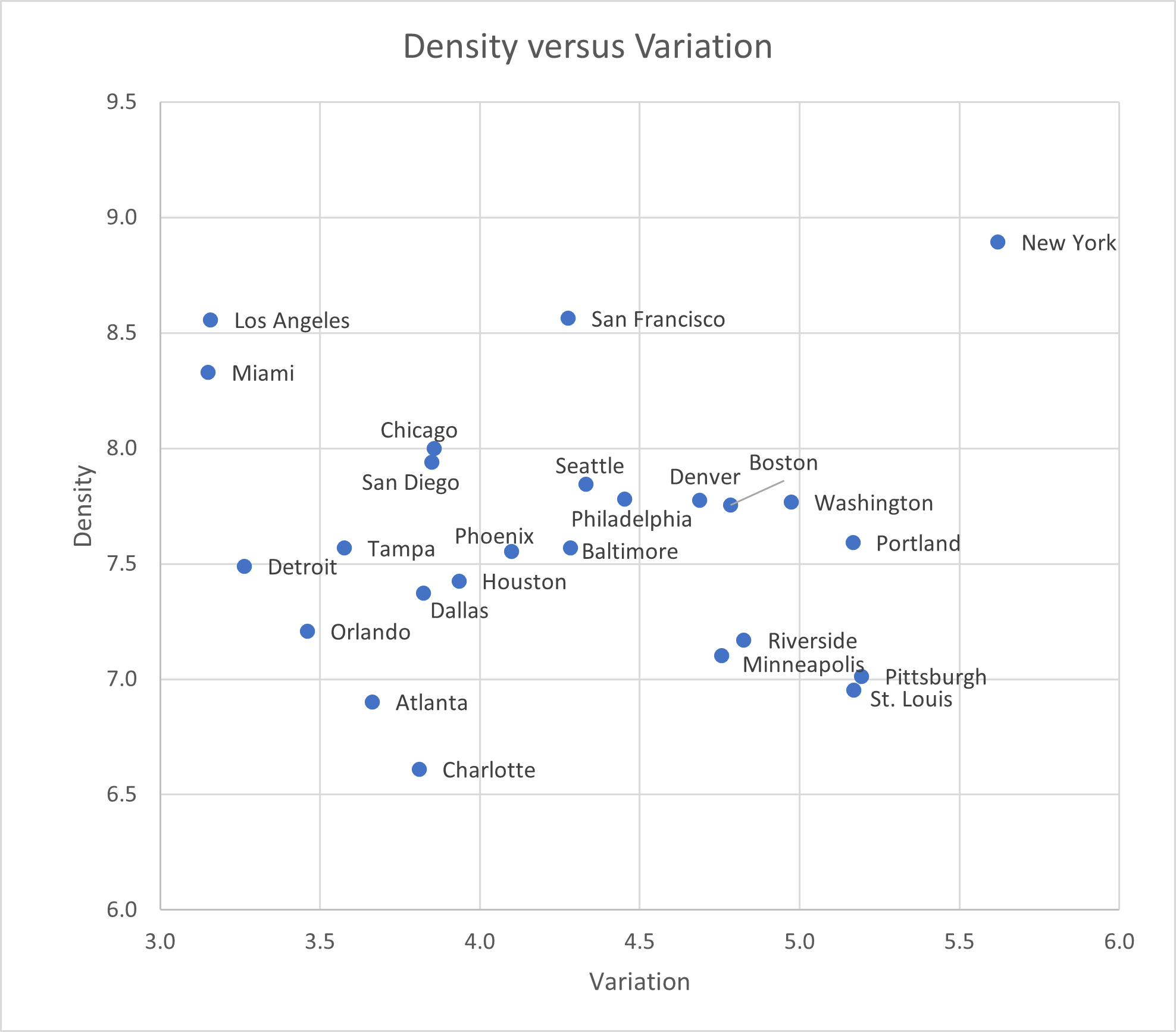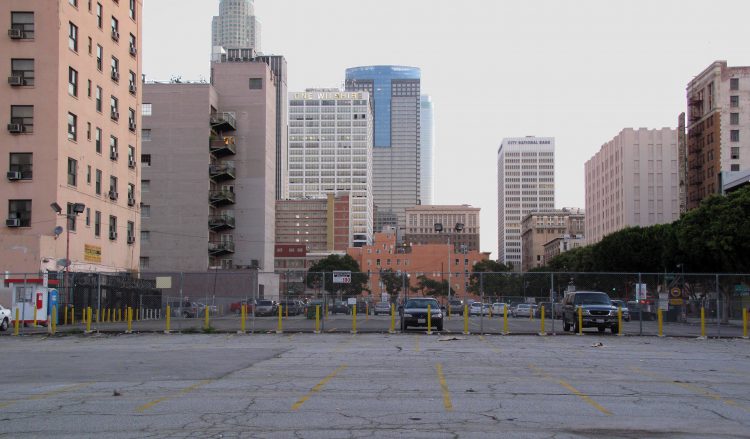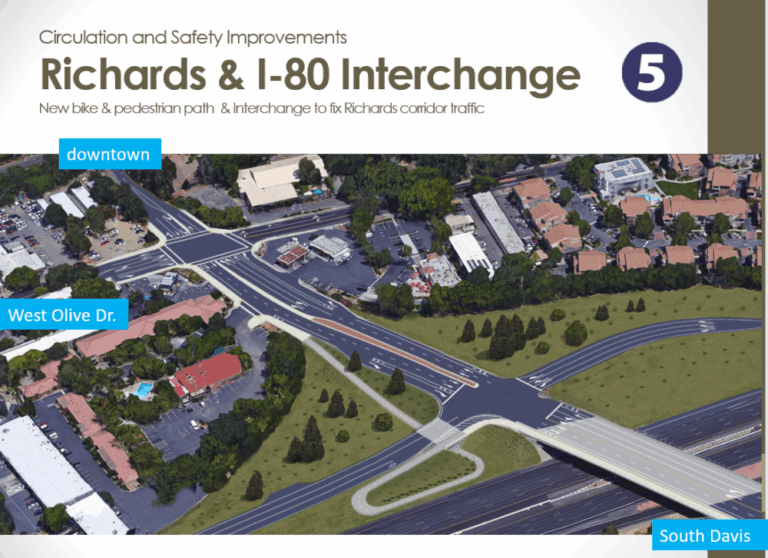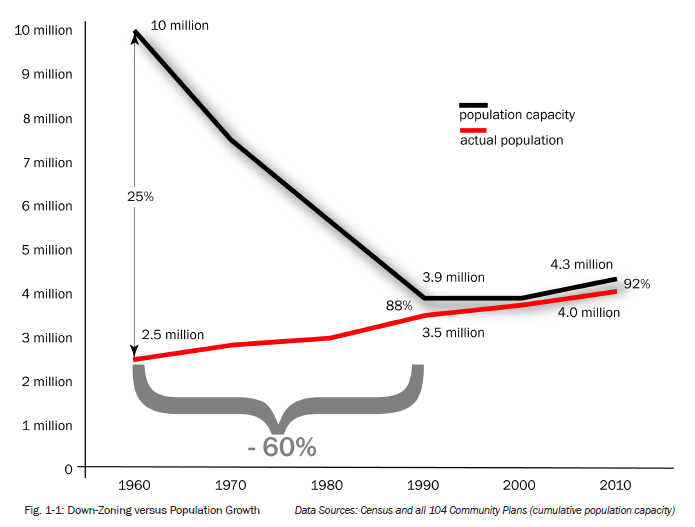Physical Address
304 North Cardinal St.
Dorchester Center, MA 02124
Physical Address
304 North Cardinal St.
Dorchester Center, MA 02124
In his new book Arbitrary Lines, Nolan Gray points out that Tokyo is more affordable than many U.S. cities because its zoning policies are less restrictive. One common counterargument is that because Tokyo is a population-losing city in a population-losing city, it simply lacks the demand to have high housing prices, and is thus more comparable to the low-cost Rust Belt than to high-cost cities like New York. But a short look at my World Almanac suggests otherwise. On page 730, it lists the world’s largest urban areas. It shows that between 2000 and 2021 , Tokyo actually grew by 8.4 percent. By contrast, metropolitan New York-Newark grew by 5.7 percent, and Los Angeles by 5.6 percent. In other words, Tokyo’s population actually grew more rapidly than high-cost U.S. cities.

A quick data exercise shows that LA really is unique among big American metros, matched only by its East Coast twin, Miami.
This book, available from solimarbooks.com, is a set of very short essays (averaging about three to five pages) on topics related to urban planning. Like me, Stephens generally values walkable cities and favors more new housing in cities. So naturally I am predisposed to like this book. But there are other urbanist and market books on the market. What makes this one unique? First, it focuses on Southern California, rather than taking a nationwide or worldwide perspective (though Stephens does have a few essays about other cities). Second, the book’s short-essay format means that one does not have to read a huge amount of text to understand his arguments. Because the book is a group of short essays, it doesn’t have one long argument. However, a few of the more interesting essays address: The negative side effects of liquor license regulation. Stephens writes that the Los Angeles zoning process gives homeowners effective veto power over new bars. As a result, the neighborhood near UCLA has no bars, which in turn causes UCLA students go to other neighborhoods to drink, elevating the risk to the public from drunk driving. The Brooklyn Dodgers’ move to Los Angeles; Los Angeles facilitated the transfer by giving land to the Dodgers- but only after a referendum passed with support from African-American and Latino neighborhoods. On the other hand, the construction of Dodger Stadium displaced a Latino community. To me, this story illustrates that arguments about “equity” can be simplistic. Los Angeles Latinos were both more likely than suburban whites to support Dodger Stadium, yet were more likely to be displaced by that stadium. So was having a stadium more equitable or less equitable than having no stadium? (On the other hand, a stadium that displaced no one might have been more equitable than either outcome). […]

The Center for Market Urbanism released its first policy report in partnership with Abundant Housing Los Angeles. The paper, written by The Center for Market Urbanism’s Nolan Gray and Emily Hamilton, recommends eliminating minimum parking requirements as part of DTLA 2040, a process which will update both the Central City and Central City North community plans. The draft concept for the DTLA 2040 plan calls for eliminating parking requirements for the Central City and Central City North neighborhoods. This would build upon the success of Los Angeles’ adaptive reuse, allowing new developments to facilitate affordable, dense, walkable neighborhoods. The paper discusses the history of parking requirements, burdens and damage caused by current parking requirements, and benefits of reforms: Combined with demand-based pricing for on-street parking, the elimination of parking requirements will allow for downtown neighborhoods that are more walkable while also reducing congestion for drivers. Read the Center for Market Urbanism/Abundant Housing LA Policy Paper here The Center for Market Urbanism is a 501c3 organization dedicated to expanding choice, affordability, and prosperity in cities through smart reforms to U.S. land-use regulation. Abundant Housing LA is 501c3 organization which is committed to advocating for more housing. We want lower rents and a more sustainable and prosperous region, where everyone has more choices of where to live and how to pursue their dreams. LA is one of the most diverse, vibrant cities in America, and we are fighting to keep it that way for current Angelenos, our children, and those who come here to pursue their dreams.

The alternative title for this piece was: “Ballot Box Zoning: Where Needed Housing Goes to Die.” Next month, Los Angeles will be voting on Measure S, a proposed 2-year policy that will effectively serve as a moratorium on new construction. That is, Measure S will require a public vote on any new development that does not fit within existing zoning. Most of the city’s major leaders, including Mayor Eric Garcetti, have come out against the measure, and the Los Angeles Times followed suit just a few days ago. I’m not going to rehash arguments for or against the measure. Instead, I’m going to offer several warnings based on the experience of Davis, CA, which passed its own Ballot Box Zoning Measure in 2000. Measure J, our ballot box zoning measure, requires voter approval on any attempt to change the zoning designation of open space or agricultural land that sits on the community’s edges. The law also explicitly names two particular parcels that must be voted on prior to approval. So for the purposes of this piece, consider it a ballot box zoning law targeting sprawl. Warning 1: These Measures Are Hard To Roll Back Measure J passed in Davis with just 53.6% percent of the vote in a March primary when residents cast just 19,000 votes (in a city with at least 49,000 voting-age residents). The law contained a renewal clause, and when it came up for renewal in 2010, support jumped to 76.7% percent. This increased support may be an artifact of how the opposition attempted to stall the measure’s renewal. Opponents of the renewal made a NIMBY argument the centerpiece of their case: they argued that slowing growth at the edge of town meant more infill pressure in the city’s core, threatening the character of neighborhoods. As I’ll discuss in a […]
[This post was originally published on the blog Better Institutions] The people who live in coastal urban cities tend to be a pretty liberal bunch. We’re leading the country on minimum wage laws, paid sick leave, climate change mitigation, and a host of other important issues. We care deeply about equality of opportunity, and we’re willing to invest our time and money to advance that effort—even if the people we help don’t always look like us or come from the same neighborhood, state, or even country. I’m proud to count myself among their number. And then we turn to housing. Maybe it’s just because we’re doing great on so many other fronts, but when I look at our inability to solve the housing crisis in places like San Francisco, New York, and Washington, D.C., I’m left feeling nothing but depression and hopelessness. It’s all the more frustrating because unaffordable housing might be the most important economic problem facing residents of liberal U.S. cities, and we’re perfectly, comprehensively, and unmistakably blowing it. The causes of this failure are too numerous to ever fully enumerate in a single blog post, and, admittedly, some are out of the hands of cities themselves. But I don’t want to be too forgiving—state and federal policy plays a role, for example, but liberal U.S. cities are also typically located in liberal U.S. states, and federal policy applies equally to all, including the cities that have managed to remain affordable. There’s also the impact of global capitalism on a few world class cities, but it’s hard to feel genuine pity for places where foreign investors are willing to dump billions of dollars. Boo-hoo. At it’s heart this is a problem of liberal governance and/or policy, and we need to face it head on. We can’t blame this on someone else. It’s our […]

Everybody in LA can agree on one thing – traffic blows hard. Harder, even, than these guys: Hate traffic? Blame parking. But here’s a secret: people don’t cause traffic. Cars do. And you know what makes people use cars? Parking. If you’ve got nowhere to put your car when you arrive, you aren’t going to drive, and you aren’t going to contribute to traffic. Research has shown that for every 10% increase in parking, 7.7% more people commute with a car. Hate high rent? Blame parking. That’s a bad start. But it gets worse. Parking is also driving up your rent. Building parking spaces is incredibly expensive – each underground parking spot in LA costs about $35,000. Even if your unit includes “free” parking, you’re paying for the cost of that parking in your rent every month, whether you want to or not. Parking is cheaper to build above ground (if you can call $27,000 cheap), but then it takes up valuable space for apartments. All those dollar signs have an impact–UCLA professor Donald Shoup has calculated that requiring parking reduces the number of units in new apartment buildings by 13%. But parking is even more insidious than that. Often, when a new housing project is proposed, one of the first things that angry people (NIMBYs) yell about is traffic. Sometimes, those NIMBYs successfully stop housing from being built, and we desperately need all the housing we can get to contain our skyrocketing rents. Then why the hell do we require all new buildings to include so much parking? You’d think, then, that developers might stop providing parking. But they can’t, because we did something really, really dumb. We’ve created a system that requires parking to be provided with all new projects. For an apartment […]
[Research help for this article was provided by UCLA student Mitchell Boswell] The past 15 years have seen a hell of a lot of gentrification in LA. 15% of our poor neighborhoods have undergone gentrification since the year 2000, and it feels like things have only accelerated since the end of the financial crisis. That’s putting a huge strain on communities across the city, from Boyle Heights to Leimert Park. But before we get into why, let’s get one thing out of the way… Academics love to debate about whether gentrification is good or bad for residents of poor neighborhoods. Maybe we should try listening to what people actually want. Some argue that when a neighborhood gentrifies, more of the existing residents stay in the neighborhood than they otherwise would (one of the many, many hard things about poverty is housing insecurity, so folks tend to move around a lot no matter what), and also tend to be more satisfied after the change. On the other side of the debate are people arguing that as gentrification occurs, the investment and new residents push up rent prices and drive out poor residents who made that community home. It’s not clear who’s right. That all seems pretty academic – it’s an argument between folks who are well-off about whether or not people in poor neighborhoods should be happy. Instead of telling people how they should feel, maybe we should stop and listen, just for a minute, to what they want. And a lot of those people sure as hell don’t seem to want gentrification. The lack of new housing on the Westside is driving gentrification There are a lot of reasons for gentrification, but the lack of new housing on the Westside deserves a lot of the blame in recent years. As […]

In 1986, a foreshadowing of today’s fight over “neighborhood integrity” was taking place, culminating in November as Los Angeles residents voted 2-to-1 to cut the development potential of thousands of parcels across the city. Of the 29,000 acres zoned for commercial and industrial uses throughout LA, 70 percent saw their development capacity sliced in half, from a floor-area ratio (FAR) of 3.0 to 1.5. Since the city allows housing to be built in many of these zones, it didn’t just mean less office, retail, and manufacturing space, but fewer homes as well. The ballot initiative responsible for these changes was called Proposition U, and it’s the reason that so many commercial corridors in LA are still characterized by 1960s and ’70s-era, single-story, dilapidated strip malls. All those arterial corridors were the ones permanently frozen in time by Prop U. THE PROPOSAL To my knowledge no one has ever assessed exactly how much this instance of “planning by the ballot” actually reduced the residential capacity of Los Angeles. By my very, very rough estimate, I would put the number somewhere on the order of 1 million homes.* But whether the actual number is 1 million, 500K, or over 2 million, the conclusion is the same: If we want to keep Los Angeles affordable for residents at all income levels, we should repeal Proposition U. Repealing Proposition U would achieve several important aims. Since we’re talking about arterial, commercial corridors, the repeal would dramatically increase the supply of transit-oriented housing over the next several decades—something we desperately need at a time of record-low residential vacancy rates if we’re to have any hope of limiting continued rent increases. It would reduce development pressures on existing communities, directing development to underutilized corridors with little to no housing on them, rather than funneling developers into single-family neighborhoods […]
[Research help for this article was provided by UCLA student Hunter Iwig] The rent in LA has gone up 30% in the last three years. What the hell? Three big things happened, two of them awesome, and one dumb. We decided living in cities was cool again (awesome), city centers are creating tons of new jobs (awesome), and we didn’t build very many new places to live in our cities (not awesome). Living in cities is cool again (awesome) In the 1950s and 1960s our cities stopped growing and people started moving to the suburbs. We kept it up for a long, long time. But something has changed in the last 10-15 years. More and more people prefer to live in walkable, urban areas. Today, 52% of Americans say they would like to live in a place where they do not need to use a car very often. For millennials, it’s even higher – 63% say they want the walkable convenience of cities. City dwellers do less environmental damage and cause less traffic, so that sounds like pretty damn good news. Cities are creating tons of jobs (awesome) New jobs used to be created in suburbs. But since the Great Recession until 2011, that’s changed – cities are where the new jobs are. And, surprise surprise, people want to move to places where they can get jobs. We’ve made it incredibly hard to build more houses in LA and other cities (not awesome) First, a quick primer. You can’t build anything you want wherever you want. Zoning and planning rules dictate what can be built on any given plot of land. In 1960, L.A. had a population of 2.5 million, but its zoning rules allowed for housing for 10 million if every lot was built to it’s maximum density. Today our […]